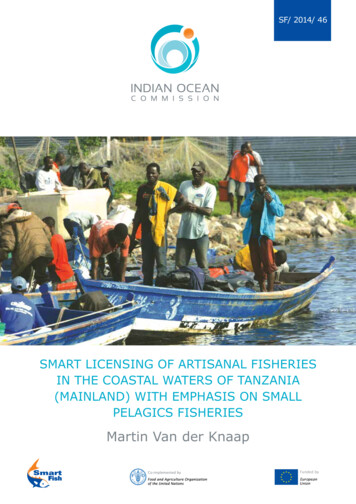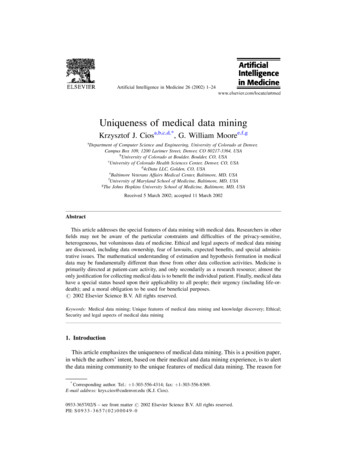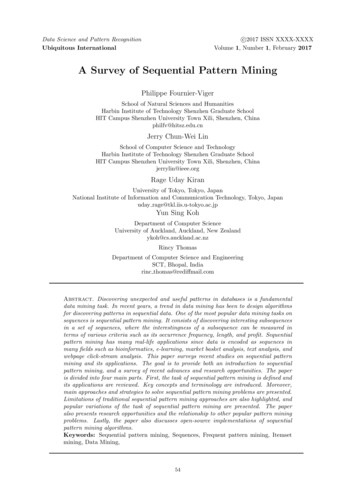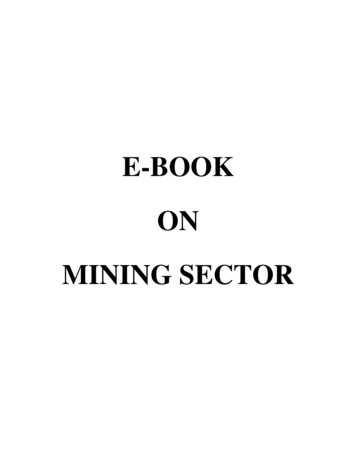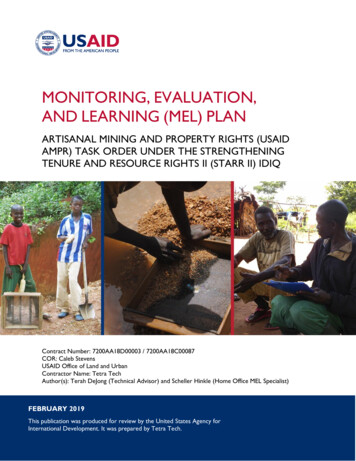
Transcription
MONITORING, EVALUATION,AND LEARNING (MEL) PLANARTISANAL MINING AND PROPERTY RIGHTS (USAIDAMPR) TASK ORDER UNDER THE STRENGTHENINGTENURE AND RESOURCE RIGHTS II (STARR II) IDIQContract Number: 7200AA18D00003 / 7200AA18C00087COR: Caleb StevensUSAID Office of Land and UrbanContractor Name: Tetra TechAuthor(s): Terah DeJong (Technical Advisor) and Scheller Hinkle (Home Office MEL Specialist)FEBRUARY 2019This publication was produced for review by the United States Agency forInternational Development. It was prepared by Tetra Tech.
This publication was produced for review by the United States Agency for InternationalDevelopment by Tetra Tech, through USAID Contract No. 7200AA18D00003 /7200AA18C00087, under the Strengthening Tenure and Resource Rights (STARR) IIIndefinite Delivery Indefinite Quantity Contract (IDIQ).Tetra Tech Contact(s):Mark Freudenberger, Project Manager159 Bank Street, Suite 300Burlington, VT 05402Tel: (802) 495-0282Fax: (802) 658-4247Email: mark.freudenberger@tetratech.comSuggested Citation:DeJong, T., & Hinkle, S. (2018). Monitoring, Evaluation, and Learning Plan.Washington, DC: USAID Artisanal Mining and Property Rights TaskOrder under the Strengthening Tenure and Resource Rights II (STARRII) IDIQ.Cover Photos:Tetra Tech, Central African Republic.
MONITORING, EVALUATION, ANDLEARNING (MEL) PLANARTISANAL MINING AND PROPERTY RIGHTS (USAIDAMPR) TASK ORDER UNDER THE STRENGTHENINGTENURE AND RESOURCE RIGHTS II (STARR II) IDIQFEBRUARY 2019DISCLAIMERThe author’s views expressed in this publication do not necessarily reflect the views of theUnited States Agency for International Development or the United States Government.
TABLE OF CONTENTS Toc2171035LIST OF ACRONYMS . ii1.0OVERVIEW OF THE ARTISANAL MINING AND PROPERTY RIGHTS (USAID AMPR)PROJECT . 11.1PURPOSE . 11.2RESULTS FRAMEWORK . 12.0REVIEWING AND UPDATING THE MEL PLAN . 33.0MONITORING AND EVALUATION PLAN . 43.1PERFORMANCE INDICATORS . 43.1.13.3Indicators. 4MANAGEMENT OF THE PERFORMANCE MONITORING SYSTEM . 93.3.1Roles and Responsibilities . 93.3.2MEL and Sub-Contracts . 103.3.3Data Collection. 103.3.4Data Analysis . 123.3.5Data Management and Use . 123.4EVALUATIONS . 123.5DATA QUALITY . 154.0LEARNING AND ADAPTIVE MANAGEMENT PLAN . 164.1CONCEPT . 164.2ADAPTIVE MANAGEMENT AND LEARNING QUESTIONS . 17ANNEX A: PERFORMANCE INDICATOR REFERENCE SHEETS (PIRS) . 19USAID AMPR MONITORING, EVALUATION, AND LEARNING (MEL) PLANi
LIST OF ACRONYMSALSAntenne Locale de Suivi (Kimberley Process monitoring committee at commune level)USAID AMPR Artisanal Mining and Property RightsASMArtisanal and Small-Scale MiningBECDORBureau d'Évaluation et de Contrôle de Diamant et d'OrCARCentral African RepublicCELCommunication, Evidence, and Learning ProjectCLACollaborating, Learning, and AdaptingCLPRComité Local de Paix et Réconciliation (local peace-building committee)CLSComité Local de Suivi (Kimberley Process monitoring committee at zone level)COPChief of PartyCORContracting Officer’s RepresentativeCSOCivil Society OrganizationDDLDevelopment Data LibraryDODevelopment ObjectiveDQAData Quality AssessmentE3/LULand and Urban Office in the Bureau for Economic Growth, Education, andEnvironmentEUEuropean UnionFACTSForeign Assistance Coordination and Tracking SystemFGDFocus Group DiscussionGISGeographic Information SystemsGoCARGovernment of the Central African RepublicGPSGlobal Positioning SystemIDIQIndefinite Delivery/Indefinite QuantityIPISInternational Peace Information ServiceIRIntermediate ResultLRGLand and Resource GovernanceLTPRLand Tenure and Property RightsKAPKnowledge, Attitudes, and PracticesUSAID AMPR MONITORING, EVALUATION, AND LEARNING (MEL) PLANii
KPKimberley ProcessKPCSKimberley Process Certification SchemeKPPSKimberley Process Permanent SecretariatM&EMonitoring and EvaluationMELMonitoring, Evaluation, and LearningMHANRMinistry of Humanitarian Action and National ReconciliationMINUSCAUnited Nations Multidimensional Integrated Stabilization Mission in CARMMGMinistry of Mines and GeologyMOVMeans of VerificationOECDOrganization of Economic Cooperation and DevelopmentOFKP Operational Framework for CAROUOperating UnitPIRSPerformance Indicator Reference SheetPMProject ManagerPRADDProperty Rights and Artisanal Diamond DevelopmentSODEMISociété pour le Développement Minier en Côte d’IvoireSOOStatement of ObjectivesSOPStandard Operating ProcedureSTARR IIStrengthening Tenure and Resource Rights IIUNCMCANational Union of Central African Mining CooperativesUSAIDUnited States Agency for International DevelopmentUSGUnited States GovernmentUSGSUnited States Geological SurveyWBWorld BankZEAZone d’Exploitation ArtisanaleUSAID AMPR MONITORING, EVALUATION, AND LEARNING (MEL) PLANiii
1.01.1OVERVIEW OF THE ARTISANALMINING AND PROPERTY RIGHTS(USAID AMPR) PROJECTPURPOSEThe USAID Artisanal Mining and Property Rights (USAID AMPR) Project’s main purpose is to addressland and resource governance challenges around the Artisanal and Small-Scale Mining (ASM) sector usinga multi-disciplinary approach and incorporating appropriate and applicable evidence and tools, takingcare to incorporate a gender lens throughout all activities. USAID AMPR serves as the United StatesAgency for International Development’s (USAID’s) flagship project for addressing the complexdevelopment challenges around the ASM sector in the Central African Republic (CAR), with a primaryfocus on diamonds and a secondary focus on gold. The project forms part of assistance provided tocountries with challenges in implementing the Kimberley Process, the international mechanism that setsrules and norms for the trade in conflict-free rough diamonds. Through its activities USAID AMPRpromotes legal, responsible supply chains and strengthens social cohesion in mining areas. In addition,the project provides on-demand short-term technical assistance on development challenges associatedwith ASM to various USAID Operating Units around the globe, with an emphasis on sub-Saharan Africa.The project supports the USAID Office of Land and Urban’s overall objective of improving land andresource governance and strengthening property rights for all members of society, especially women.For the purpose of data collection, monitoring, and evaluation this MEL plan parallels the Annual WorkPlan submitted under separate cover. The monitoring period each year is from October 1 – September30th.1.2RESULTS FRAMEWORKThe project is designed around the following theory of change:IF USAID AMPR strengthens the legal chain of custody for diamonds and gold through trainingand capacity-building, regulatory reform, empowerment of communities through land andresource planning, improving stakeholder coordination and supporting peace-building andreconciliation, THEN compliance with Kimberley Process (KP) requirements will increase—which will promote licit economic opportunities, and enable community resilience and socialcohesion to increase—allowing ASM stakeholders to respond to new opportunities;AND IF successful approaches adopted for the diamond sector are extended to the gold sector,AND IF key linkages between ASM and complex development issues are addressed, THEN allstakeholders in the ASM sector worldwide stand to benefit from improved livelihoods, peace,and stability.In order to progress through USAID AMPR’s theory of change, USAID AMPR activities will bestructured around four objectives: Objective 1: Assist the Government of CAR (GoCAR) to improve compliance with KPrequirements to promote licit economic opportunities.Objective 2: Strengthen community resilience, social cohesion, and response to violent conflict inCAR.USAID AMPR MONITORING, EVALUATION, AND LEARNING (MEL) PLAN1
Objective 3: Increase awareness and understanding of the opportunities and challenges ofestablishing responsible gold supply chains in CAR. Objective 4: Improve USAID programming through increased understanding of linkages betweenASM and key development issues.For each objective, one or more Intermediate Results (IRs) define key activities and expected outcomes.These are: IR 1.1: Improve legal, policy, and institutional framework for conflict-free diamond production atdomestic and regional levels;IR 1.2: Expand formalization of land and resource rights in artisanal diamond mining communities; IR 1.3: Increase awareness of Kimberley Process requirements, inclusive of all points in the supplychain such as government actors, buying houses, collectors, pit owners, and diggers; IR 1.4: Strengthen capacity of GoCAR to manage and expand KP-compliant zones effectively; IR 2.1: Support inclusive community dialogue especially between different religious and ethnicgroups to resolve conflict over land and natural resources; IR 2.2: Promote women’s economic and social empowerment in ASM communities in furtheranceof broad-based social and economic inclusion;IR 2.3: Strengthen cooperation between GoCAR ministries and agencies and other stakeholders onsocial cohesion and Kimberley Process compliance;IR 3.1: Research and communicate recommendations for policy, legal, and institutional reforms atthe national and regional levels to key stakeholders; IR 4.1: Assist relevant USAID Operating Units to assess the link between ASM and developmentissues; andIR 4.2: Strengthen knowledge sharing and understanding of USAID Operating Units and partners onthe link between ASM and development issues.All USAID AMPR activities have been designed under this framework. In addition, project performanceindicators are designed to measure progress related to these IRs and their respective Objectives.USAID AMPR MONITORING, EVALUATION, AND LEARNING (MEL) PLAN2
2.0REVIEWING AND UPDATING THE MELPLANThe Monitoring, Evaluation, and Learning (MEL) Plan serves as a tool to guide overall projectperformance. As such, the team will update it as necessary to reflect changes in USAID AMPR’s strategyand ongoing tasks. Updates will also incorporate feedback from USAID as well GoCAR. Monitoring,evaluation, and learning are therefore not one-time occurrences, but rather part of an ongoing processof review, revision, and implementation. The MEL team will review the MEL Plan annually, update ifnecessary, and submit a revised version along with the proposed Annual Work Plan (AWP). For thispurpose, the monitoring period each year is from October 1 – September 30th.USAID AMPR MONITORING, EVALUATION, AND LEARNING (MEL) PLAN3
3.0MONITORING AND EVALUATION PLAN3.1PERFORMANCE INDICATORS3.1.1INDICATORSUSAID AMPR’s performance indicator table (Table 1) presents a range of both custom and standardindicators at the output, outcome, and impact levels. The table also includes all the standard foreignassistance indicators (“standard indicators” or “F indicators”) relevant to project activities. USAIDAMPR will also track custom outcome indicators to measure the eight results listed in the contract plusseveral custom crosscutting indicators. The team will disaggregate indicator data reported bytask/country and all person-level indicators by gender, except where government-provided data doesnot allow disaggregation.1 The Performance Indicator Reference Sheets (PIRSs) in Annex A contain fulldetails for each indicator, including use of indicator, baseline procedures, data collection methodologies,data quality assurance measures, and justifications for proposed targets.1This will be the case for data on numbers of licensed artisanal miners and buyers, which are not gender disaggregated.USAID AMPR MONITORING, EVALUATION, AND LEARNING (MEL) PLAN4
TABLE 1. USAID AMPR INDICATOR TABLEN.B.: The monitoring period each year is from October 1 – September 30th. Q1 for Year I is considered October 1, LINEObjective 1: Assist GoCAR to improve compliance with KP requirements to promote licit economic opportunities.Percentage of estimated rough diamond production1 in KP-compliant zones that is legally exported fromAnnually8%5CAR15%25%40%50%CARN PERFORMANCE INDICATOR(AND TYPE)Y54LOPTARGET260%60%6Percentage of major diamond-mining sub-prefectures2 in the Western part of the country authorized by theKimberley Process to export rough diamondsAnnually31%7CAR25%30%50%75%100%100%3 Number of licensed (registered) artisanal 0002In the case that the two options years are not exercised by USAID, Year 3 targets will become Life of Project targets.3Option Year.4Option Year.5The baseline of 8% is derived by dividing the exports from 2018 (approximately 13,000 carats) over the estimated production from the 5 KP-compliant zones in 2017(164,000 carats). USGS did not estimate production for 2018 at the time of writing but there is no reason to believe that it decreased. On the contrary, PRADD IIgeoreferencing in April and May 2018 showed mining at a constant intensity in all zones. The figure of 13,000 carats of exports does not include approximately 63,000 caratsexported in early 2018 but which were held up from 2017 due to unanswered questions by the KP Monitoring Team.6Even if the CAR government regained full control of its territory and diamond trade, experience from the USAID PRADD project shows that at least 25% of productionwould continue to be smuggled. As such 60% legal exports is an ambitious target that assumes a strong improvement in state control. Of note is that smuggling would behigher when measuring production by value rather than volume, as more valuable stones are more likely to be smuggled. USAID AMPR will only measure by volume.7USAID AMPR estimates that 32 of the country’s 72 sub-prefectures have diamond mining or potential diamond mining. Of these, 16 are considered by experts and by theCAR government as concentrating the vast majority of the Western region’s production. 5 of these 16 are currently compliant; the baseline is therefore 31%.8This figure is an estimate based on available government data for the number of miners registered in 2018. Because this data is not fully centralized in Bangui, but remains inthe provinces, an exact figure is not possible. USAID AMPR will work on improving the consolidation of data in Bangui.USAID AMPR MONITORING, EVALUATION, AND LEARNING (MEL) PLAN5
N PERFORMANCE INDICATOR(AND 3Y43Y54LOPTARGET2Number of diamond buyers (collectors and buying4 houses) making purchases with official purchase slipsAnnually2009CAR250300350400500500Percentage of artisanal miners in project intervention5 zones with basic knowledge of KP and Mining CodeAnnuallyTBDCARN/A40%1050%60%75%75%Number of specific pieces of land tenure andproperty rights legislation or implementingregulations proposed, adopted, and/or implemented6 positively affecting property rights of the urbanand/or rural poor as a result of USG assistance(Standard F Indicator EG.10.4-1)Annually0CARN/AN/AN/AN/AN/A5Number of adults who perceive their tenure rights7 to land or marine areas as secure as a result of USGassistance (Standard F Indicator 2514Objective 2: Strengthen community resilience, social cohesion, and response to violent conflict in CAR.Number of villages having formalized and8 strengthened their natural resource managementAnnually0CARN/AN/AN/Acapacity9The baseline figure shows the approximate number of registered dealers (collectors and buying houses), not the number of active and legal dealers. At present thegovernment’s data does not allow easy disaggregation of the number of actors versus the number of actors who are legally purchasing, a distinction that USAID AMPRcapacity-building will make possible.10Miner Knowledge, Attitudes, and Practices (KAP) surveys will take place in the first half of the year and will capture results from a miner sensitization campaign. As such,Year 3 targets will assess activities from Year 2, etc.11The first-year data from the KAP in 2019 will constitute the baseline.12Given that the first year’s KAP survey will determine the baseline, first year performance data will not be collected.13This assumes that the KAP survey is repeated in the second year of the project. Per the AMPR contract, the KAP survey will only take place 3 times, but this may beadjusted in the Annual Work Plan.14This figure is an estimate of the number of villages that could be part of the Zone d’ Exploitation Artisanale (ZEA) pilots. The total number of villages in the project’sintervention areas is approximately 25.USAID AMPR MONITORING, EVALUATION, AND LEARNING (MEL) PLAN6
N PERFORMANCE INDICATOR(AND 3Y43Y54LOPTARGET2Number of groups trained in conflictmediation/resolution skills or consensus-building9 techniques with United States Government (USG)assistance (Standard F Indicator DR.3.1-2)Annually0CARN/AN/AN/AN/AN/A1515Number of USG supported events, trainings, oractivities designed to build support for peace or10 reconciliation among key actors to the conflict(Standard F Indicator PS.6.2-3)Annually0CARN/AN/AN/AN/AN/A6016Number of local women participating in a substantiverole or position in a peacebuilding process supported11 with USG assistance (Standard F Indicator GNDR10)Annually0CARN/AN/AN/AN/AN/A3017Number of consensus building forums (multi-party,12 civil/security sector, and/or civil/political) held withUSG Assistance (Standard F Indicator DR.3.1-3)Annually0CARN/AN/AN/AN/AN/A20Number of disputed land and property rights casesresolved by local authorities, contractors, mediators,13 or courts as a result of USG assistance (Standard FIndicator EG.10.4-3)Annually0CARN/AN/AN/AN/AN/A50Number of individuals who have received USGsupported short-term agricultural sector productivity14 or food security training (Standard F 15This is an estimate of the number of Comités Locaux de Paix et Réconciliation (CLPRs) (Peace and Reconciliation Committees) that will be created.16Assumes at least one activity or event per CLPR per year.17Assumes at least one woman in a leadership role per CLPR and per Antenne Locale de Suivi (ALS)/ Comité Local de Suivi (CLS) (KP monitoring committees).USAID AMPR MONITORING, EVALUATION, AND LEARNING (MEL) PLAN7
4 TARGET2LINEObjective 3: Increase awareness and understanding of the opportunities and challenges of establishing responsible gold supply chains inCAR.Number of gold mining sites integrated into the15 interactive mapping systemAnnually0CARN/AN/AN/AN/AN/A100N PERFORMANCE INDICATOR(AND TYPE)Objective 4: Improve USAID programming through increased understanding of linkages between ASM and key development issues.Number of activities benefitting USAID Operating16 Units aimed at improving the understanding ofAnnually0GlobalN/AN/AN/AN/AN/A10linkages between ASM and key development issuesUSAID AMPR MONITORING, EVALUATION, AND LEARNING (MEL) PLAN8
3.3MANAGEMENT OF THE PERFORMANCE MONITORING SYSTEM3.3.1ROLES AND RESPONSIBILITIESThe following people/entities will play key roles in USAID AMPR’s performance monitoring system: Project Manager. The USAID AMPR Project Manager (PM) will be responsible for finalizing theindicator tables and narratives portions of the project’s annual reports. The PM will also have overallresponsibility for specific MEL-related reports, such as the outcomes of the Miner Knowledge,Attitudes, and Practices (KAP) Survey. The PM will coordinate with the USAID ContractingOfficer’s Representative (COR) on any specific indicator or MEL needs, including annual reportingfor Standard F indicators, liaising with the CEL project, etc.Home Office MEL Specialist. Tetra Tech’s Home Office MEL Specialist will provide technicalbackstopping for the MEL plan, including assistance in drafting the present plan and futureamendments to it, ensuring compliance with relevant USAID regulations and best practices, assistingin the sampling methodology and survey instruments for miner KAP surveys, capacity building forlocal staff and preparing internal Data Quality Assessments (DQAs).Chief of Party. The Chief of Party will have overall responsibility for the implementation of MELactivities in the CAR. He will supervise the Monitoring & Evaluation (M&E) Coordinator, liaise withthe Technical Deputy and Project Manager on MEL needs, assist in compiling indicators and spotchecking Means of Verification (MOVs) for annual reports, liaise with local government partners toensure timely and quality data submission, and coordinate the execution of MEL activities in theannual work plan such as the Miner KAP Survey.Technical Deputy. The Technical Deputy will be the technical lead on developing andimplementing the MEL plan, including facilitating discussions needed to define and refine indicators,reviewing terms of reference and technical documents for MEL activities like the Miner KAP Survey,liaising with technical partners like USGS on key indicators, providing capacity-building to GoCARdata collection and management authorities, integrating MEL activities into the annual work planningdrafting and review process, and training the M&E Coordinator and field agents in coordination withthe COP and MEL Specialist.Monitoring & Evaluation (M&E) Coordinator. The M&E Coordinator based in CAR will haveday-to-day responsibility in data collection and analysis, including the preparation of indicator Meansof Verification, the maintenance of an internal database of data, analysis of data for the annualreports, working with government counterparts (KP focal points, Kimberley Process PermanentSecretariat [KPPS], Bureau d'Évaluation et de Contrôle de Diamant et d'Or [BECDOR]) for datacollection and quality assurance, maintenance of spatial data, identification of success stories andqualitative evidence of project impact, and facilitation of learning activities during staff retreats andannual work plan reviews in collaboration with the government.Field Agents. Field Agents will have day-to-day responsibilities for data collection and compilationfor certain indicators, working in close coordination with the M&E Coordinator. For example, fieldagents will monitor that KP Focal Points and CLPRs are correctly recording data related to miningsites and conflicts. In addition, field agents will collect and compile data that is needed for reportingbut may not be included in indicators, such as agricultural productivity of women’s groups. Finally,field agents will, as part of periodic, reporting include qualitative information on project results andimpact.Component Coordinators. Local Component Coordinators in charge of activities under eachproject Objective will ensure that the MEL plan is integrated into general activity implementation.For example, in the establishment of CLPRs, the Component 2 Coordinator will ensure that focalUSAID AMPR MONITORING, EVALUATION, AND LEARNING (MEL) PLAN9
points for each committee are trained in the use of the conflict register necessary for collecting dataon conflicts resolved with USGS assistance. In addition, the Component 1 Coordinator will ensurethat government counterparts have sufficient capacity and resources to collect data needed tomeasure USAID AMPR performance. The Coordinators will also take into account data and learningin the design of activities.GoCAR. GoCAR will have direct responsibility for the collection and transmission of keyinformation related in particular to mining actor registration (buyers and miners) andproduction/export data. USAID AMPR will work with the relevant agencies, in accordance with itsMemorandum of Understanding (MoU) with the government, to ensure that data is collected in atimely manner and in compliance with data quality standards set in the PIRS. Specific actors withroles to play include the KP Focal Points in project intervention areas, Regional Mining Directors,the KP Permanent Secretariat, BECDOR (for export statistics), and the General Director of Minesand Geology.USGS. USGS will liaise with USAID AMPR in estimating production levels, notably in identifyingactive mining quadrants to sample and in providing other contextual data on levels of miningactivities. USAID AMPR will also share data collection results with USGS that are relevant to itsmonitoring role in the KP, including production data and results from Miner KAP Survey.USAID CEL. USAID AMPR will work with its COR to identify ways in which the Communication,Evaluation and Learning (CEL) project can assist and benefit from the project’s activities. Forexample, USAID AMPR could assist CEL in developing and finalizing blogs or other communicationand outreach materials. In addition, CEL could provide feedback on sampling methodologies foractivities such as the Miner KAP Survey. USAID AMPR will work through the COR on anycollaboration.International Peace Information Service (IPIS). Sub-contractor IPIS will be responsible fordata collection for the indicator on mapping gold sites. The transmission and updating of this datawill be integrated into the terms of reference of their sub-contract. In addition, USAID AMPR willendeavor to harmonize data collection instruments between IPIS, GoCAR and USAID AMPR. Forexample, an integrated questionnaire will be developed for both gold and diamond sites, which willallow integration into the public mapping interface of data collected by KP Focal Points and USAIDAMPR from diamond mining areas.3.3.2MEL AND SUB-CONTRACTSUSAID AMPR will sub-contract Component 3 work to IPIS and RESOLVE with respect to gold. As such,IPIS will be responsible for collecting data on active gold mining sites and integrating into an interactivemapping system. The number of sites identified and integrated into this system will form the basis of oneof USAID AMPR’s indicators. As such, USAID AMPR will ensure that this obligation is integrated intothe IPIS sub-contract and establish clear modalities for data-sharing and data quality assurance.3.3.3DATA COLLECTIONData collection methods will vary by indicator and are described in detail in the PIRS for each indicatorlocated in Annex A. Table 2 below offers a summary of major data collection tools.USAID AMPR MONITORING, EVALUATION, AND LEARNING (MEL) PLAN10
TABLE 2. DATA COLLECTION METHODSDATA COLLECTIONTOOLDESCRIPTION OF METHODSampling of activeproduction zonesIn order to determine the percentage of rough diamond production that isexported legally, USAID AMPR must estimate actual rough diamond production,which is the indicator’s denominator. Estimating actual production levels is notstraight forward as an infinitesimal portion is registered in official productionnotebooks. In the past under the USAID Property Rights and Artisanal DiamondDevelopment I and II (USAID PRADD I and II) project, the government estimatedproduction based on initial sales data in regional trading centers. However, withthe expansion of smuggling, and the KP suspension applied to most zones, thismethod is no longer reliable. USAID AMPR will therefore collaborate with theUSGS, who periodically identify active mining sites throughout the country througha square-kilometer grid and classification system using satellite images. USAIDAMPR will work with USGS to develop a representative sample of sites that willthen undergo ground-truthing by project and partner agents. Using an averageproductivity per square kilometer, USGS/USAID AMPR will then offer a roughestimate of actual production. USAID AMPR will also use data from Miner KAPSurvey and other sources to refine this estimate and will document themethodology and its limitations.Miner KAP Surveysand site monitoringsurveysUSAID AMP
The USAID Artisanal Mining and Property Rights (USAID AMPR) Project's main purpose is to address land and resource governance challenges around the Artisanal and Small-Scale Mining (ASM) sector using a multi-disciplinary approach and incorporating appropriate and applicable evidence and tools, taking






